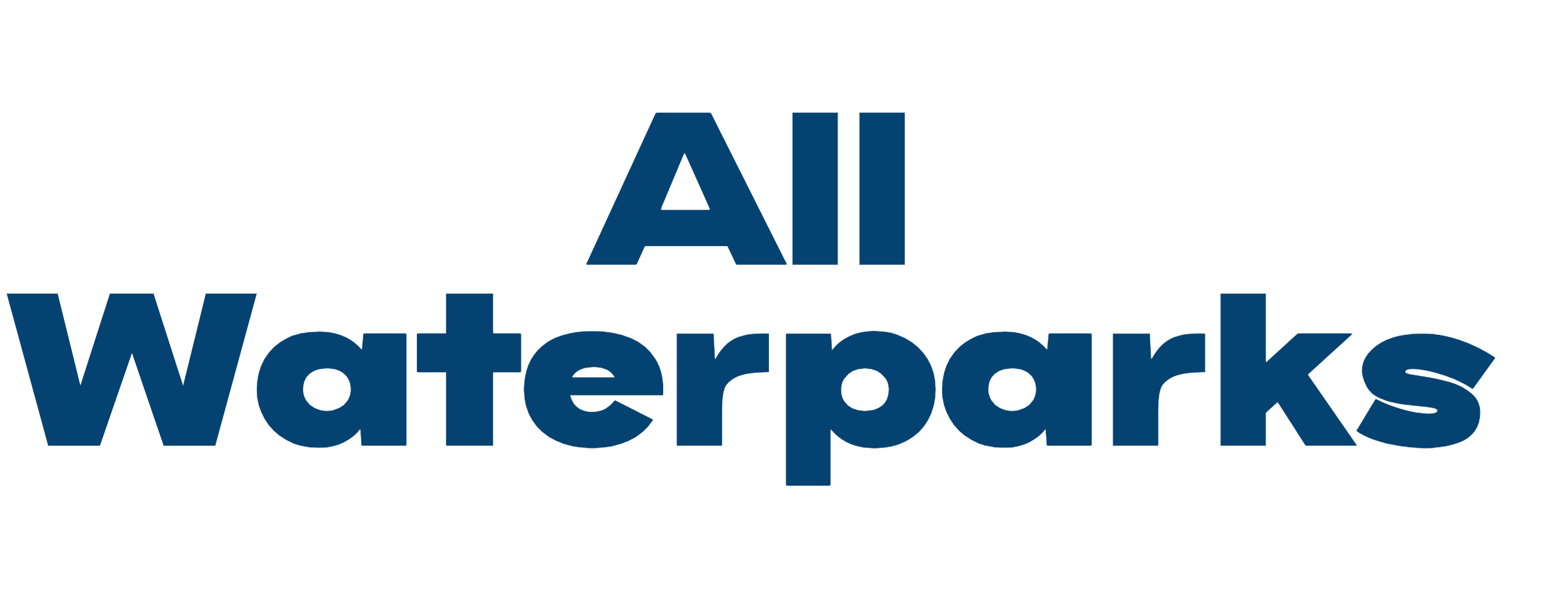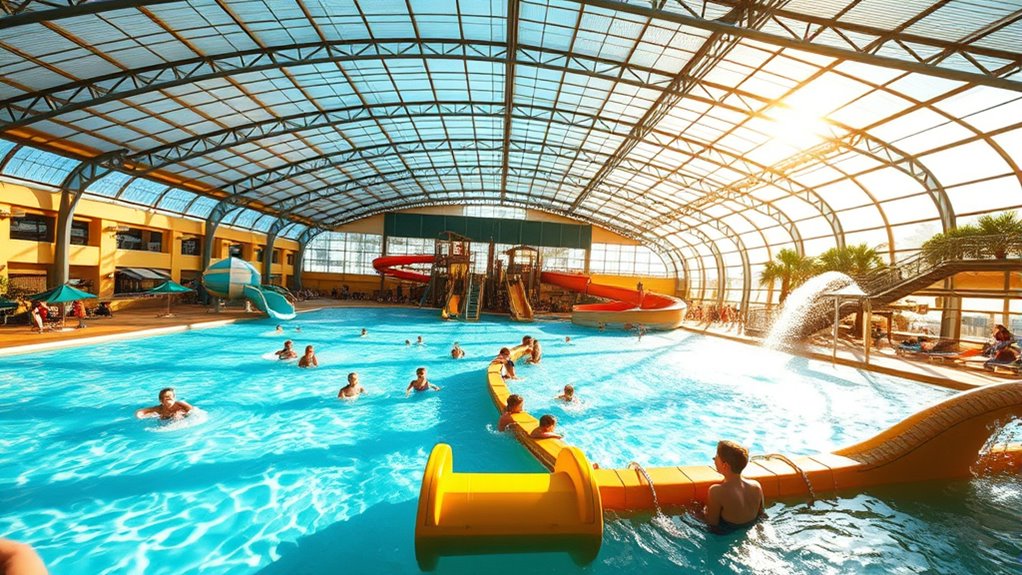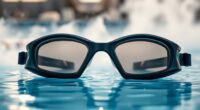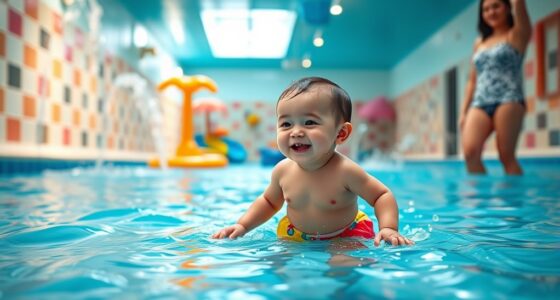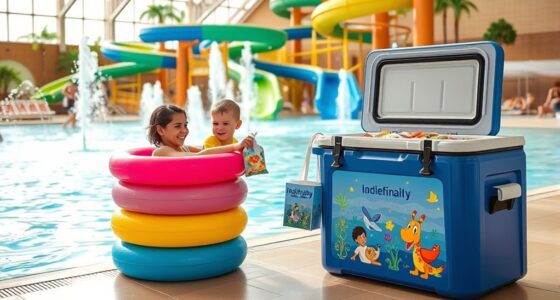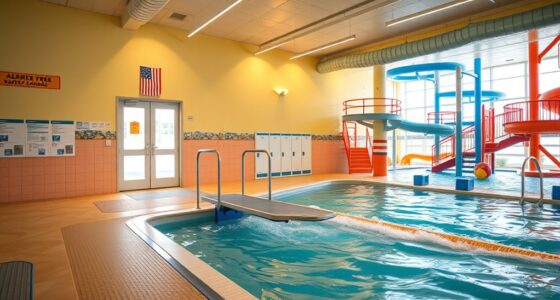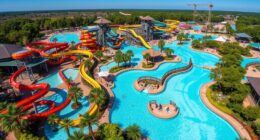Indoor water parks generally don’t use real sunlight because they are enclosed environments with roofs that block natural light, relying instead on artificial lighting. They also use UV-C light systems to disinfect water effectively, breaking down microbes without chemicals. Combining UV with chlorine improves water quality and reduces skin and eye irritation. To learn how these lighting and disinfection methods work together and impact your experience, keep exploring these innovative technologies.
Key Takeaways
- Indoor water parks are enclosed spaces with limited or no natural sunlight due to roof materials and structural design.
- They primarily rely on artificial lighting, including UV-C light, for water disinfection and maintaining water quality.
- UV disinfection uses UV-C light to neutralize pathogens, often combined with chlorine to enhance water safety.
- Natural sunlight is generally not used inside indoor water parks because their roofs block direct sunlight.
- Advanced lighting systems, including UV and LED technology, are employed to improve safety, energy efficiency, and guest comfort.
Why Natural Sunlight Is Rare Inside Indoor Water Parks

Indoor water parks rarely have natural sunlight because their enclosed roofs are designed to maintain climate control, which blocks direct sunlight from entering. Most roofs use materials like metal or opaque membranes that prioritize insulation and durability but don’t let light through. Window openings are limited due to safety concerns, humidity, and structural needs, further reducing natural light. Additionally, many parks lack skylights or transparent panels, decreasing the chance for sunlight to penetrate inside. This design helps control temperature and humidity but means you mostly rely on artificial lighting. The goal is to create a comfortable environment, but it comes at the expense of natural sunlight, making indoor water parks feel more enclosed and less connected to the outdoor environment. Natural lighting is often considered a beneficial feature for outdoor spaces, but it is rarely incorporated into indoor water park designs.
The Role of Artificial UV Light in Water Disinfection
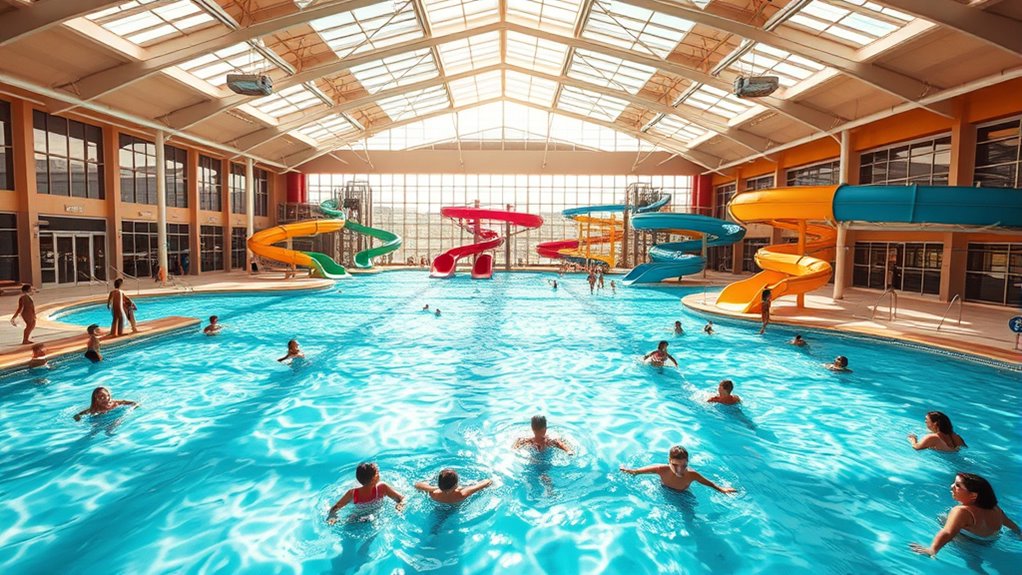
Artificial UV light plays a crucial role in water disinfection by rapidly neutralizing microorganisms such as bacteria, viruses, and protozoa that are resistant to chemical disinfectants. UV-C light at around 254 nm damages microbial DNA, preventing reproduction and killing pathogens like Cryptosporidium and Giardia. It disinfects water quickly without needing holding tanks or reaction times, making it efficient and effective. Regulatory agencies like the USEPA and FDA recognize and approve UV disinfection for safety. UV systems operate continuously, providing reliable treatment 24/7, and include fail-safe mechanisms to prevent untreated water flow during power outages. This method avoids adding chemicals, preserves water quality, and is environmentally friendly, making it a popular choice for indoor water parks seeking safe, chemical-free disinfection. Additionally, the use of UV disinfection technology is supported by extensive scientific research demonstrating its effectiveness against a wide range of pathogens.
How UV Water Treatment Systems Operate
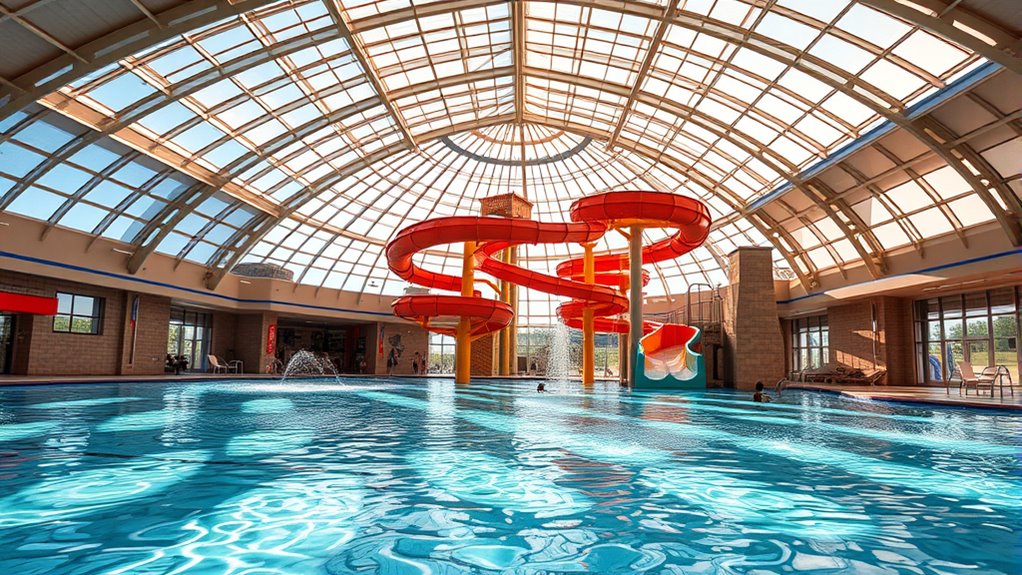
UV water treatment systems use specialized lamps to emit germicidal UV-C light that destroys microbes’ DNA, preventing reproduction. Water flows through the reactor chamber, where exposure time and UV intensity determine effectiveness. Proper flow rates and water clarity are essential for ensuring thorough disinfection. UV-C light at 254 nm wavelength is specifically effective at neutralizing microorganisms, making it a reliable method for water sterilization. Additionally, understanding Mazda Tuning can help owners optimize their vehicle’s performance for better handling and efficiency.
UV Disinfection Process
Have you ever wondered how UV water treatment systems effectively inactivate harmful microorganisms? These systems use UV-C light at around 254 nm to target bacteria, viruses, and protozoa. The UV light damages their DNA or RNA, breaking chemical bonds and preventing replication or infection. This process happens instantly, causing microorganisms to lose essential functions. The effectiveness depends on UV intensity and exposure time, with a recommended dose of at least 16,000 µW•sec/cm². Regular maintenance, like replacing lamps and cleaning quartz sleeves, is essential to keep the system working efficiently. Unlike chemicals, UV treatment leaves no residual substances or by-products. It’s a quick, environmentally friendly method that’s highly effective against resistant pathogens, making it ideal for water safety in indoor water parks. Additionally, understanding the lighting environment helps optimize UV disinfection effectiveness and ensures a safe, enjoyable experience for visitors.
Water Flow and Exposure
Water flow through UV treatment systems is carefully designed to guarantee microorganisms receive an effective dose of germicidal UV-C light. To achieve this, water moves continuously through a reactor chamber optimized for UV exposure. Maintaining the correct flow rate is essential; too fast, and microbes won’t receive enough UV, while too slow reduces efficiency. Flow control devices help keep flow steady during peak demand. Proper chamber design ensures uniform UV exposure by minimizing turbulence and dead zones. Additionally, the chamber’s reflective surfaces maximize UV light distribution. Flow rate is typically monitored and adjusted using specialized sensors to ensure optimal disinfection performance. Ensuring proper UV dose delivery is critical for effective microbial inactivation and safe water quality.
The Synergy Between UV Light and Chlorine

You can enhance pool sanitation by combining UV light with chlorine, which allows you to lower chemical levels while maintaining effective disinfection. UV breaks down chloramines and harmful byproducts, reducing odors and irritation, so you don’t need as much chlorine. This synergy improves water quality, cuts chemical use, and saves costs on maintenance. UV radiation breaks down chloramines, preventing their buildup, which further supports healthier swimming conditions. Incorporating eye patch benefits knowledge can also remind pool operators to consider skin and eye safety for bathers exposed to UV and chlorine.
Enhanced Disinfection Synergy
The synergy between UV light and chlorine considerably enhances disinfection efficiency in indoor water parks by combining their complementary mechanisms. You benefit from chlorine damaging viral capsids, making pathogens more vulnerable to UV’s nucleic acid damage. Simultaneously, UV and chlorine generate reactive radicals that attack microorganisms further. UV also breaks down chloramines, reducing the irritants and odors associated with chlorine use. This combined approach allows you to use lower chlorine doses and shorter contact times without sacrificing safety. It also minimizes harmful disinfection by-products, improving water and air quality. You’ll notice fewer chloramines, less chlorine smell, and enhanced overall water clarity. Plus, this synergy extends equipment lifespan and simplifies compliance with health standards, making your indoor water park safer and more enjoyable. Disinfection synergy has been shown to improve overall microbial removal efficiency, which helps maintain a healthier environment for visitors and staff. Incorporating disinfection methods that leverage this synergy can lead to more effective and efficient water treatment processes.
Reduced Chemical Dependency
By integrating UV light with chlorine, indoor water parks can substantially reduce their reliance on chemical disinfectants. UV breaks down chloramines, the compounds responsible for the strong chlorine smell and irritation, improving water quality and swimmer comfort. It disrupts molecular bonds in chloramines without altering water chemistry, preventing pH shifts. UV also accelerates free chlorine breakdown, releasing chlorine gas and lowering the amount needed for effective sanitation. As a result, chlorine levels can be reduced from typical 0.3–0.5 mg/L to 0.1–0.3 mg/L, cutting chlorine use by at least 50%. This synergy minimizes disinfection byproducts, reduces eye and skin irritation, and improves water clarity. Proper system design guarantees UV effectively supports chlorine’s disinfecting power while decreasing chemical dependency and maintaining safe, healthy pool environments. UV’s ability to break down chloramines further contributes to improved water quality and swimmer comfort.
Benefits of UV Disinfection for Swimmer Health and Comfort
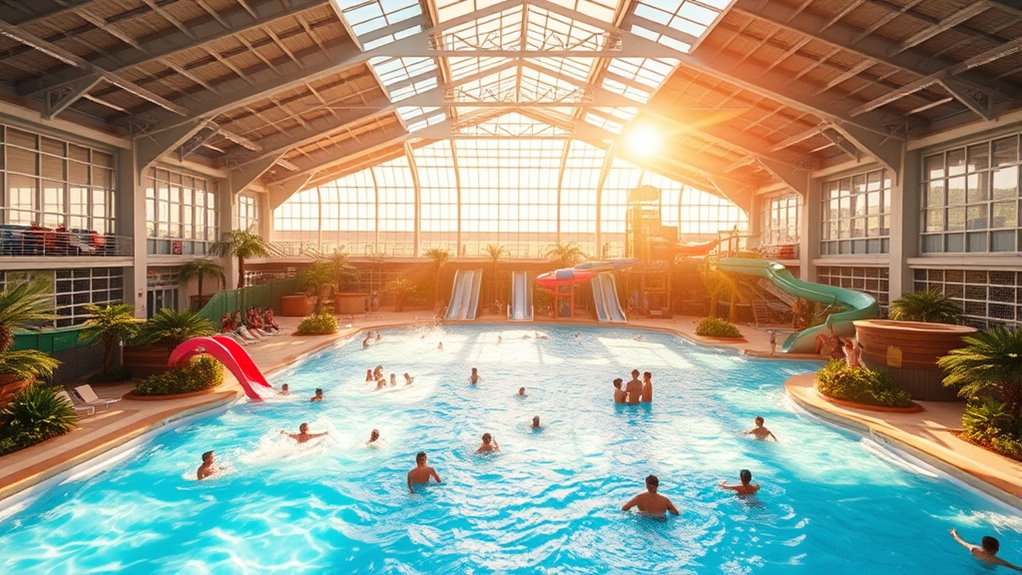
UV disinfection substantially enhances swimmer comfort and health by improving water quality and reducing chemical irritants. By effectively killing bacteria, viruses, and other pathogens, UV systems keep the water clearer and safer. They also lower the need for chlorine, which can cause skin and eye irritation. This reduction leads to less eye redness and skin discomfort during and after swimming. Additionally, UV treatment eliminates chloramines, responsible for harsh odors and respiratory discomfort, improving indoor air quality. The continuous operation of UV systems ensures consistent disinfection, maintaining a healthier environment.
- Keeps water clearer and safer, reducing irritants
- Minimizes skin and eye irritation
- Enhances air quality by breaking down chloramines
Environmental Advantages of UV Water Treatment
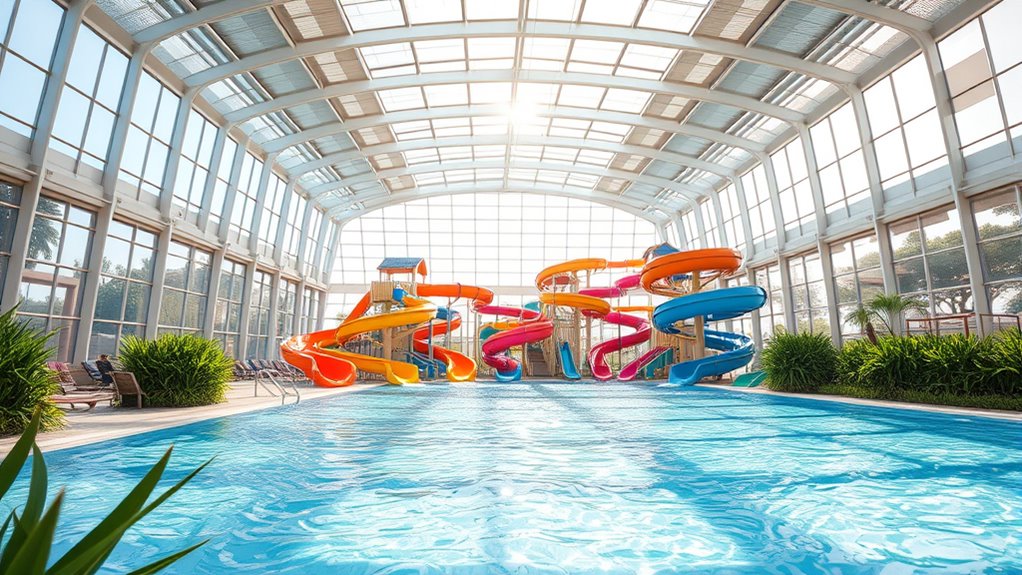
Choosing UV water treatment offers significant environmental benefits because it disinfects without relying on chemicals, reducing the production of harmful by-products and minimizing chemical waste. Unlike chlorine or chloramine systems, UV eliminates the formation of toxic disinfection by-products like trihalomethanes, protecting ecosystems and reducing chemical handling risks. Modern UV systems are energy-efficient, consuming less power and lowering your carbon footprint, supporting sustainability goals. They also prevent the creation of hazardous residues, maintaining water quality without altering taste or pH. UV disinfection effectively inactivates a wide range of pathogens, including chlorine-resistant germs like Cryptosporidium, ensuring safety with minimal environmental impact. Plus, UV systems conserve resources by avoiding water loss during treatment and require minimal maintenance, reducing waste and infrastructure footprint. UV technology is also scalable and suitable for various settings, from small-scale residential systems to large municipal plants. Additionally, advancements in UV system durability ensure long-term performance, further reducing the need for replacements and waste.
Selecting the Right UV System for Indoor Water Parks
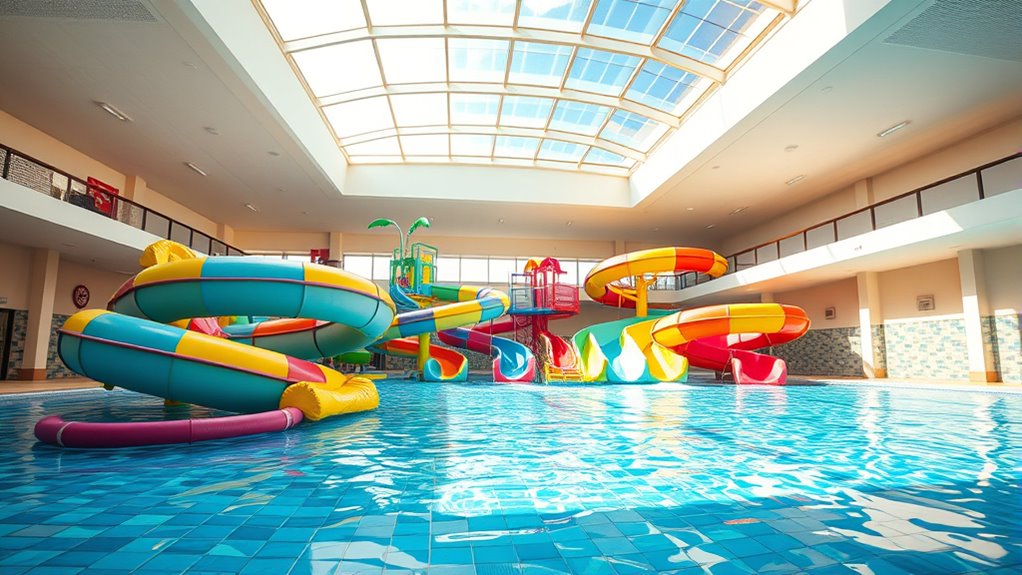
Selecting the right UV system for indoor water parks is essential to guarantee effective disinfection while maintaining cost-efficiency. You need to take into account factors like flow rate compatibility to make sure the system can handle your pool’s volume. Choosing between low-pressure and medium-pressure UV systems depends on your specific needs: low-pressure models are energy-efficient and cost-effective, while medium-pressure units deliver higher UV output for tougher pathogen inactivation. Additionally, evaluate bulb life and power requirements to reduce maintenance and operational costs. Keep in mind your pool size to select a system that fits—smaller pools can use compact models, whereas larger facilities may need more robust solutions. Ease of installation and integration with existing infrastructure are also vital for smooth setup and ongoing operation. Filtration systems, including UV treatment, work together to ensure comprehensive disinfection and maintain water quality.
Future Trends in Indoor Water Park Lighting and Disinfection

Indoor water parks are embracing innovative lighting and disinfection technologies that enhance guest experiences while prioritizing safety and sustainability. LED lighting dominates, offering energy efficiency, long lifespan, and dynamic effects like color changes and themed displays. Smart controls and automation enable real-time adjustments, personalized scenes, and optimized energy use. Solar and renewable energy integration reduces reliance on grid power, supporting eco-friendly operations and green certifications. Advanced disinfection methods, such as LED-based UV-C systems and far-UVC light, target pathogens effectively while minimizing chemical use. Robotic UV disinfection units operate during off-hours, ensuring thorough cleaning without guest disruption. LED lighting’s versatility allows for creative and immersive environments, making the experience more engaging for visitors. Additionally, the development of disinfection technologies that are both effective and environmentally friendly continues to evolve, aligning with the goals of sustainable operation. Future trends focus on smarter, more sustainable lighting and disinfection solutions that improve safety, reduce costs, and create immersive, environmentally conscious environments for visitors.
Frequently Asked Questions
Can Indoor Water Parks Simulate Natural Sunlight for Aesthetic Purposes?
Yes, indoor water parks can simulate natural sunlight for aesthetic purposes. You might find advanced LED lighting systems that mimic sunlight’s spectrum and intensity, creating a warm, inviting atmosphere. These lights can change dynamically, replicating day-night cycles or filtering through water effects. This technology enhances guest experience by making the environment feel more natural and open, all while maintaining indoor comfort and energy efficiency.
Are UV Disinfection Systems Effective Against All Types of Indoor Waterborne Pathogens?
Think of UV disinfection as a vigilant guardian, but even guardians have limits. It’s highly effective against many waterborne pathogens, including bacteria and viruses resistant to chlorine. However, it doesn’t eliminate all contaminants or spores, especially if improperly designed or maintained. You need to combine UV with other treatments for maximum protection. So, while it’s a powerful tool, it isn’t a catch-all solution for every pathogen in indoor water environments.
How Often Do UV Lamps Need to Be Replaced in Water Park Systems?
You should replace UV lamps in water park systems every 12 months, which typically equals about 9,000 hours of operation. Regular replacement guarantees the UV system works effectively to eliminate microorganisms and maintain water safety. Keep an eye on usage and environmental conditions, as some systems may need more frequent maintenance. Always follow manufacturer guidelines to keep your water treatment system running smoothly and effectively.
Do UV Systems Produce Any Safety Hazards or UV Exposure Risks?
UV systems are like silent guardians, but they do carry safety risks if mishandled. Direct UV-C exposure can cause skin burns and eye irritation, especially during maintenance or repairs. However, in waterparks, the UV light stays enclosed, so patrons aren’t at risk. Proper training, safety labels, and regular equipment checks make certain these systems keep everyone safe—like a shield, guarding from unseen dangers.
Can UV Lighting Improve Water Clarity and Reduce Chemical Usage Simultaneously?
Yes, UV lighting can improve water clarity and reduce chemical use at the same time. When you install UV systems, they break down microorganisms and algae, making the water clearer. This process also lessens the need for chemicals like chlorine, lowering your exposure to harmful by-products. You get healthier, cleaner water, and save money on chemicals, all while enjoying a safer swimming environment.
Conclusion
Remember, a picture is worth a thousand words, but a clean, safe water experience is priceless. While natural sunlight is rare indoors, advanced UV and lighting systems keep the water sparkling and safe for everyone. By understanding how these technologies work together, you guarantee a healthier, more enjoyable visit. Trust in innovation, because in the world of indoor water parks, staying ahead means providing the best for your guests—safety and fun go hand in hand.
